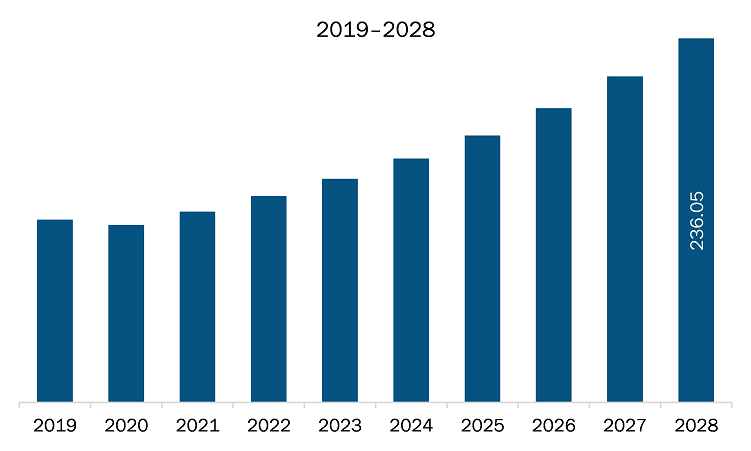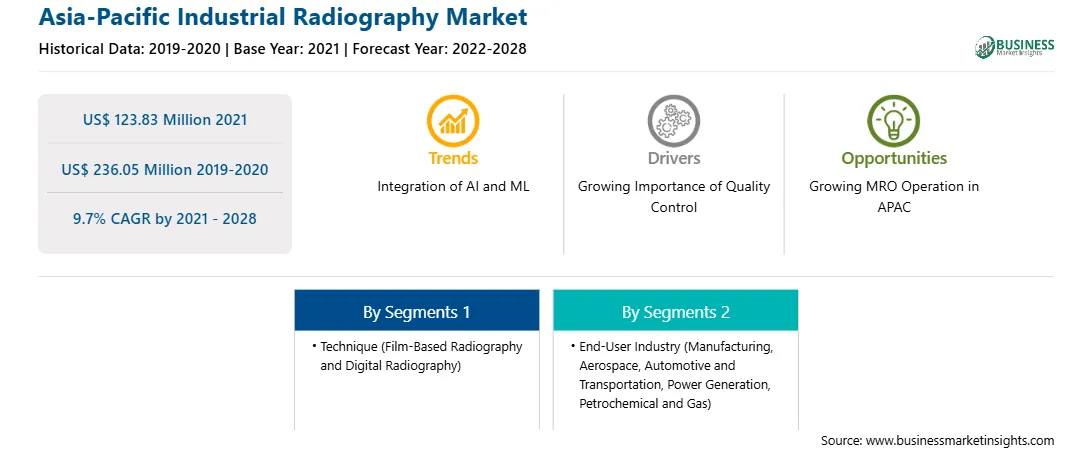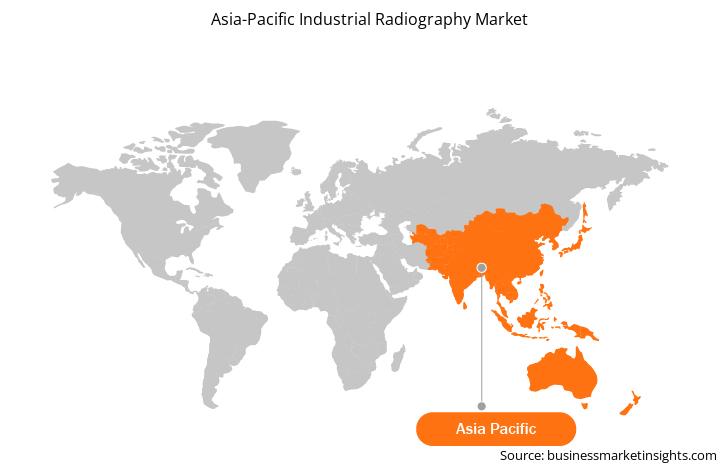The APAC industrial radiography market is segmented into Australia, China, India, Japan, South Korea, and the Rest of Asia Pacific. The region holds enormous growth potential for businesses owing to the presence of fast-growing economies, such as India and China. It also comprises major industries, such as chemicals, automobiles, manufacturing, and aerospace. China, the world's largest manufacturing hub, is witnessing a hike in labor costs due to the country's aging population. This has piqued the interest of manufacturers in investing in Southeast Asian countries. A few other factors attracting manufacturing companies to APAC countries include developing infrastructure and increasing domestic demand. Further, government policies, such as Make in India and Made in China 2025, promote the establishment of manufacturing plants to make the respective economies self-sufficient and capable of exporting surplus goods. Thus, the growing manufacturing sector across the region is subsequently influencing the adoption of industrial radiography. APAC has a robust automotive sector, which is supported by the growing automotive manufacturing industry in China, India, and South Korea. India, China, South Korea, and Japan are among the leading vehicle manufacturing countries across the world. Further, APAC has the presence of major automotive manufacturers, such as Suzuki, Mitsubishi, Hyundai-Kia, Nissan, Tata Motors Limited, Lexus, and Toyota. In addition, brands such as Ford, Mercedes, BMW, VW, Tesla, Audi, and JLR have established their manufacturing facilities in the region. Moreover, governments of APAC countries have established initiatives for the development of the automotive industry. For instance, in 2019, the government of India announced its plan worth US$ 388.5 million to set up research and development centers to enable the automotive industry to meet global standards.
Asia-Pacific constitutes the world’s two most populated countries—India and China—that are also manufacturing hubs. China virtually imposed strict lockdown and social isolation due to the COVID-19 outbreak, which almost halted the manufacturing and production for several weeks. Moreover, the country suspended the import and export of critical raw materials and components in early 2020. India also imposed a nationwide lockdown to keep a check on the growing COVID-19 cases across the country. As a result, lockdown, and disruption of industrial activities across China and India restricted the supply chain of various raw material and goods. However, these countries had to permit the manufacturing of a few essential goods. Additionally, the industries have begun to recover from the impact of the pandemic. Due to significant breakthroughs and technological innovations in manufacturing industries, the industrial radiography market in APAC is quickly expanding. Because of the region's developing manufacturing sector, industrial radiography systems are widely used. The industrial radiography market in this region is being driven by the adoption of automation in production and increasing infrastructural growth in countries such as India and China. As several countries in APAC are active in the construction of defense aircraft, the aerospace & defense sector also contribute to the growth of the industrial radiography market. The COVID-19 pandemic has a negative impact on the industrial radiography market in major APAC countries.

Strategic insights for the Asia-Pacific Industrial Radiography provides data-driven analysis of the industry landscape, including current trends, key players, and regional nuances. These insights offer actionable recommendations, enabling readers to differentiate themselves from competitors by identifying untapped segments or developing unique value propositions. Leveraging data analytics, these insights help industry players anticipate the market shifts, whether investors, manufacturers, or other stakeholders. A future-oriented perspective is essential, helping stakeholders anticipate market shifts and position themselves for long-term success in this dynamic region. Ultimately, effective strategic insights empower readers to make informed decisions that drive profitability and achieve their business objectives within the market.

| Report Attribute | Details |
|---|---|
| Market size in 2021 | US$ 123.83 Million |
| Market Size by 2028 | US$ 236.05 Million |
| Global CAGR (2021 - 2028) | 9.7% |
| Historical Data | 2019-2020 |
| Forecast period | 2022-2028 |
| Segments Covered |
By Technique
|
| Regions and Countries Covered | Asia-Pacific
|
| Market leaders and key company profiles |
The geographic scope of the Asia-Pacific Industrial Radiography refers to the specific areas in which a business operates and competes. Understanding local distinctions, such as diverse consumer preferences (e.g., demand for specific plug types or battery backup durations), varying economic conditions, and regulatory environments, is crucial for tailoring strategies to specific markets. Businesses can expand their reach by identifying underserved areas or adapting their offerings to meet local demands. A clear market focus allows for more effective resource allocation, targeted marketing campaigns, and better positioning against local competitors, ultimately driving growth in those targeted areas.

The industrial radiography market in APAC is expected to grow from US$ 123.83 million in 2021 to US$ 236.05 million by 2028; it is estimated to grow at a CAGR of 9.7% from 2021 to 2028. Increasing importance for border security; innovative active interrogation approaches to identify threats to national security are required to protect a country’s airports, borders, and ports. All detection approaches need a source of energetic particles for inducing specific reactions that are major signatures for detecting fissile material or conventional explosives or to perform imaging. The most instant perceived threats and their essential materials comprise conventional explosives, special nuclear materials, mass destruction weapons, chemical agents, and contraband. The radiography technology can be utilized to scan cargo to guarantee that nothing is being smuggled into the country. By utilizing industrial radiography technology, it is possible to distinguish between different materials. Also, the governments are investing a significant amount in border security by deploying the latest technologies at borders. For instance, the Chinese government plans to construct additional 215 airports by 2035. Also, by 2024, the Indian government plans to build 100 new airports across the country. The growth in the construction and expansion of airports is anticipated to boost the demand for industrial radiography. This is bolstering the growth of the industrial radiography market.
Based on technique, the market is bifurcated into digital radiography and film-based radiography. In 2020, the digital radiography segment held the largest share APAC industrial radiography market. By end-user industry, the market is segmented into petrochemical and gas, power generation, manufacturing, aerospace, automotive & transportation, and others. In 2020, the automotive & transportation segment held the largest share APAC industrial radiography market.
A few major primary and secondary sources referred to for preparing this report on the industrial radiography market in APAC are company websites, annual reports, financial reports, national government documents, and statistical database, among others. Major companies listed in the report are Anritsu, Comet Group, Fujifilm Corporation, GENERAL ELECTRIC, METTLER TOLEDO, Nikon Corporation, SHIMADZU CORPORATION, and ZEISS International among others.
The Asia-Pacific Industrial Radiography Market is valued at US$ 123.83 Million in 2021, it is projected to reach US$ 236.05 Million by 2028.
As per our report Asia-Pacific Industrial Radiography Market, the market size is valued at US$ 123.83 Million in 2021, projecting it to reach US$ 236.05 Million by 2028. This translates to a CAGR of approximately 9.7% during the forecast period.
The Asia-Pacific Industrial Radiography Market report typically cover these key segments-
The historic period, base year, and forecast period can vary slightly depending on the specific market research report. However, for the Asia-Pacific Industrial Radiography Market report:
The Asia-Pacific Industrial Radiography Market is populated by several key players, each contributing to its growth and innovation. Some of the major players include:
The Asia-Pacific Industrial Radiography Market report is valuable for diverse stakeholders, including:
Essentially, anyone involved in or considering involvement in the Asia-Pacific Industrial Radiography Market value chain can benefit from the information contained in a comprehensive market report.